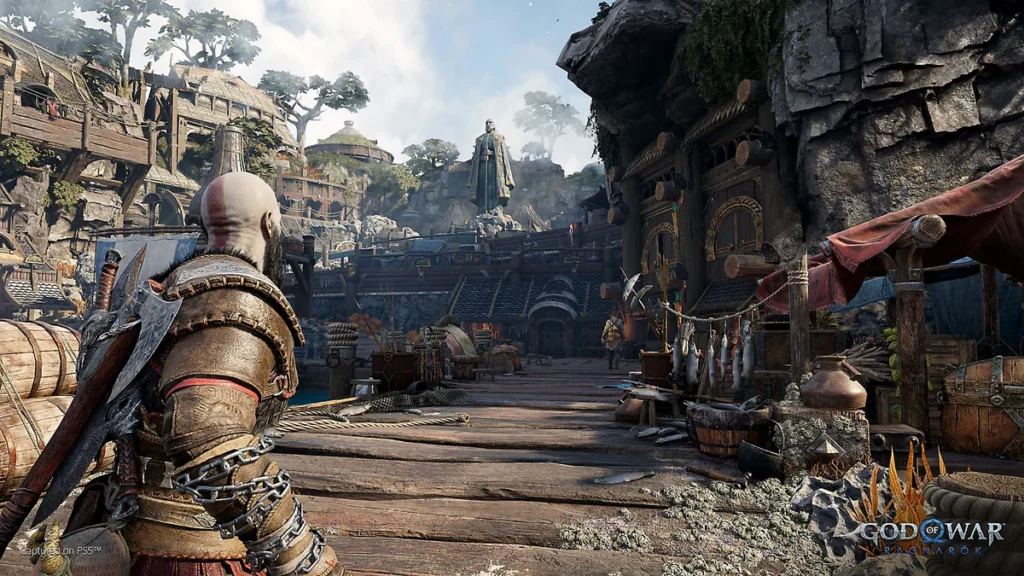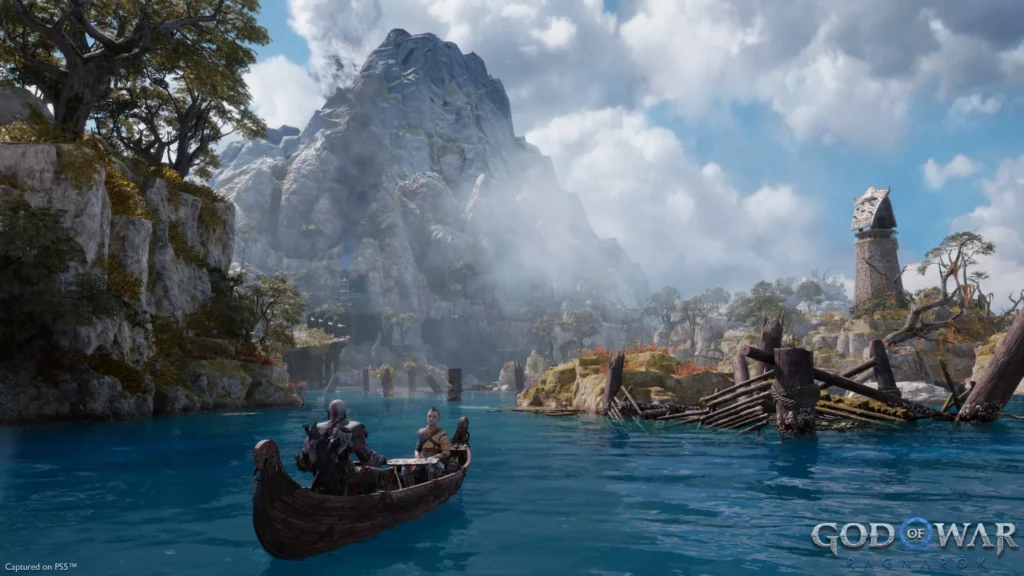Introduction to Game Mechanics and Narrative
Game mechanics serve as the foundational elements that drive player interactions within video games. These mechanics encompass the rules and systems that dictate how players engage with the game world, from basic actions like movement and jumping to more complex systems involving strategy and resource management. When video games are designed thoughtfully, mechanics do not exist in isolation; rather, they are intricately interwoven with the narrative, enhancing the storytelling experience. Understanding this interplay is crucial, especially in games like The Last of Us Part II and God of War Ragnarok, where both gameplay and story are critical to player engagement.
The significance of game mechanics extends beyond mere functionality; they shape the emotional landscape of the narratives presented. For instance, in The Last of Us Part II, mechanics such as stealth and resource management contribute directly to the themes of survival, loss, and moral ambiguity that permeate the storyline. Players are invited not only to navigate the physical challenges of the environment but also to grapple with the ethical decisions their characters must face, which ultimately heightens emotional investment in the story. Similarly, in God of War Ragnarok, combat mechanics and puzzle-solving elements serve to deepen the player’s connection to Kratos and Atreus, allowing them to experience the narrative in a more immersive manner.
Thus, it becomes evident that a comprehensive understanding of game mechanics is essential for both players and developers. This understanding informs not only the gameplay experience but also the emotional impact of the narrative. By recognizing how mechanics shape the unfolding story, players can engage with the material on a deeper level, while developers can craft more compelling and resonant narratives that leverage the full potential of game mechanics.
The Role of Game Mechanics in Narrative Development
Game mechanics play a crucial role in shaping the narrative experience of players in titles like The Last of Us Part II and God of War Ragnarok. These mechanics encompass a range of elements, including player choice, exploration, and combat systems, each contributing to a multi-faceted storytelling process that actively engages players, encouraging them to invest emotionally in the narratives presented.

One significant aspect of game mechanics is the incorporation of player choice. In The Last of Us Part II, players face various moral dilemmas that influence the outcome of the story. Such choices resonate with the players, creating a personalized narrative that evolves based on their decisions. This dynamic fosters a stronger emotional bond with the characters, as players grapple with the consequences of their actions, thereby enhancing the overall narrative impact. In contrast, God of War Ragnarok utilizes player choice through character development paths that allow individuals to shape the protagonist’s abilities and relationships, providing a sense of agency that reinforces their involvement in the unfolding story.

Exploration mechanics also significantly influence the narrative experience. Both titles encourage players to investigate their environments meticulously. In The Last of Us Part II, scavenging for resources and uncovering environmental storytelling elements promote a deeper understanding of the world, further immersing players in the character’s journey. God of War Ragnarok leverages exploration to reveal hidden lore that enriches the narrative backdrop, encouraging players to engage with the setting while uncovering critical plot points in a subtle yet impactful manner.
Lastly, combat systems serve not merely as gameplay elements but as vehicles for narrative expression. In both games, the mechanics of combat reflect the emotional state of the characters, with the intensity of battles mirroring their internal conflicts. This direct correlation between gameplay and storytelling enhances players’ connection to the narrative, as they experience the struggles and triumphs of the characters through active participation. As demonstrated, the integration of game mechanics into narrative development greatly facilitates a richer, more immersive storytelling experience, allowing players to connect with the emotional depth of the games.
Case Study: The Last of Us Part II – Mechanics That Enhance Emotion
The Last of Us Part II stands as a prominent example of how game mechanics can enhance emotional engagement. One of the pivotal mechanics is dynamic character interactions, which are designed to foster a sense of realism and empathy. Players are immersed in emotionally charged dialogues and situations that develop characters in a more profound way. These interactions are not merely scripted sequences; they evolve based on players’ choices, making decisions impactful and heightening emotional stakes. The relationship between Ellie and other characters, particularly her complex connection with Joel and later, Abby, illustrates how gameplay fosters deeper understanding and investment in each character’s journey.
Another crucial mechanic in The Last of Us Part II is environmental storytelling, which enriches the game’s narrative. Players encounter abandoned locations, remnants of a once-thriving society, and subtle visual cues that serve as a backdrop to the emotional narrative. For instance, finding personal items or observing environmental details allows players to piece together stories of loss, survival, and tragedy that enhance their emotional connection to the overarching themes of the game. Such storytelling invites players to engage with the world on a more personal level, prompting reflection on the characters’ journeys and the broader implications of their actions.
Furthermore, the game employs innovative gameplay elements that confront players with moral dilemmas, significantly impacting emotional engagement. Combat scenarios often present choices that force players to consider the ramifications of their actions, underscoring the themes of revenge and forgiveness that permeate the narrative. This mechanic not only challenges players in terms of strategy but also compels them to reflect on their ethical stance, thereby deepening the emotional resonance of the story. Through these skillfully crafted mechanics, The Last of Us Part II effectively intertwines gameplay with narrative to create a rich emotional experience.
Case Study: God of War Ragnarok – Blending Combat with Story
In God of War Ragnarok, the integration of combat mechanics with narrative elements stands as a hallmark achievement in modern game design. The game artfully marries intense combat with a deep, emotionally charged storyline, thus enhancing player immersion and engagement. As players navigate the complex realms of Norse mythology, they are not just battling foes but also participating in Kratos’ and Atreus’ personal journeys. This seamless blend ensures that every encounter feels significant, further propelling the narrative forward.

The game’s combat system is designed to reflect character growth and emotional stakes. For instance, as players progress through the game, Kratos and Atreus acquire new abilities and weapons that echo their evolving relationship and individual arcs. Each combat style, from melee to strategic range attacks, is meticulously crafted not just to challenge the player but to also symbolize the internal conflicts and development of the characters. This thoughtful connection enhances player empathy, making the heroes’ triumphs and losses resonate on a deeper level.

Moreover, God of War Ragnarok implements a dynamic storytelling technique that relies heavily on combat encounters to advance the plot. Contextual dialogue during battles offers glimpses into characters’ thoughts and emotional states, reinforcing the themes of sacrifice, loyalty, and growth. Additionally, the game’s pacing ensures that moments of intense combat are interspersed with quieter narrative exploration, allowing players to absorb the story while simultaneously engaging in thrilling gameplay. This unique approach to blending combat with storytelling is what elevates God of War Ragnarok from a mere action game to a profound narrative experience, tightly linking the gameplay mechanics to the emotional core of the story.
Player Agency and Choice – Creating an Engaging Experience
Player agency and choice are fundamental components of modern storytelling in video games, enhancing narrative depth and player engagement. In both “The Last of Us Part II” and “God of War Ragnarök,” these elements manifest through mechanics that encourage players to make impactful decisions that shape the game’s outcome and character arcs. This design approach transforms players into active participants, where their choices carry significant weight and contribute to nuanced storytelling.
In “The Last of Us Part II,” player agency is intricately linked to the themes of consequence and morality. The game confronts players with morally ambiguous situations, where the choices made by characters impact not only their journeys but also the emotional responses of the players. The mechanics that allow for player decisions create a complex narrative web, highlighting the weight of each choice. The game invites players to consider the repercussions of their decisions, effectively illustrating the broader theme of the cycle of violence and its consequences in a post-apocalyptic world.
Similarly, “God of War Ragnarök” enriches its narrative through choices that enhance player agency. While the game also weaves a compelling story of familial bonds and mythology, it integrates moments where player decisions influence the story’s direction and character relationships. This engagement facilitates a deeper connection to the narrative, illustrating how choices reflect broader moral themes throughout the mythological landscape. Players navigate conflicts and dilemmas that challenge them to reflect on the essence of sacrifice and loyalty.
Both titles exemplify how player agency and choice are not merely superficial mechanics, but integral to creating immersive narratives. Through these experiences, players are invited to reflect on their values and beliefs, highlighting the profound impact that choice has in shaping stories. Consequently, this interactivity fosters a more engaging and personal connection to the game’s overarching themes, ultimately elevating the narrative experience.
Visual and Audio Mechanics as Narrative Tools
In both “The Last of Us Part II” and “God of War Ragnarök,” the integration of visual and audio mechanics serves as fundamental tools for storytelling, enriching the narrative and elevating player engagement. Visual cues, such as lighting, color palettes, and environmental design, contribute significantly to the emotional weight of the narrative. For instance, in “The Last of Us Part II,” the stark contrast between the desolate environments and moments of tranquility not only highlights the characters’ struggles but also reflects their internal states. This visual storytelling method allows players to glean information and evoke empathy without explicit dialogue.
Similarly, in “God of War Ragnarök,” the use of vibrant colors and intricate details in the game’s landscapes enhances the sense of discovery. The varied atmospheres—from the cold, frost-covered regions to vibrant realms filled with flora—serve to immerse players into the richly woven lore of Norse mythology, highlighting the game’s narrative depth. Each visual element is designed to resonate emotionally with players, creating an immersive experience that deepens their connection to the story.
Sound design further complements these visual elements, adding layers of immersion that are crucial to both gameplay and narrative. In “The Last of Us Part II,” ambient sounds, such as distant gunfire or subtle wildlife noises, help establish environmental tension, echoing the precariousness of the characters’ existence. Meanwhile, the score dynamically shifts to reflect the protagonist’s emotional journey, enhancing key moments of tension or relief seamlessly within the gameplay.
In “God of War Ragnarök,” the soundscapes are intricately crafted, with updates to audio effects and voice acting that bring the characters to life. The incorporation of Norse musical elements not only aids in creating an authentic atmosphere but also serves to drive the narrative forward. Together, these visual and audio mechanics create a compelling game experience, ensuring that players remain emotionally invested in the unfolding story.
Comparative Analysis – The Thrill of Gaming and Narrative Depth
The Last of Us Part II and God of War Ragnarok, while distinct in their storytelling methods, both demonstrate how game mechanics can be intricately woven into narrative depth. Both titles leverage core themes such as risk, luck, and strategy, which serve not only to engage players but also to deepen the emotional impact of their stories. In The Last of Us Part II, the mechanics of stealth and combat create a continuous sense of risk; players must navigate through an environment fraught with enemies, feeling the weight of their choices. This risk is amplified by the game’s brutal combat mechanics, which emphasize the severe consequences of each action taken by the player. As players confront the challenges posed by their surroundings, they are not merely playing to win but are forced to grapple with the moral implications of their gameplay decisions.
Conversely, God of War Ragnarok employs a blend of strategy and luck through its intricate combat system and puzzle design. The inclusion of RPG elements allows players to customize their abilities, fostering a strategic layer that encourages thoughtful engagement with the narrative. Luck plays a significant role as well, particularly in obtaining rare resources or achieving specific combat outcomes that can influence the unfolding narrative. This complexity gives rise to moments of triumph and failure that resonate deeply with players, adding a personal layer to the epic tale of Kratos and Atreus.
Both games also showcase the significance of player agency within their narratives. In The Last of Us Part II, the emotional stakes are inextricably linked to player choices, weaving a story that is uniquely shaped by individual paths taken. In God of War Ragnarok, while the narrative is more linear, the interactive elements allow players to feel powerful agency over the pacing and execution of their journey. The interplay of risk, luck, and strategy in both games ultimately enhances the overall narrative experience, demonstrating how thoughtfully designed mechanics can breathe life into the stories told within.
Impact of Narrative-Driven Mechanics on Players
The integration of narrative-driven mechanics within video games such as The Last of Us Part II and God of War Ragnarok significantly enhances the emotional engagement of players. These games have successfully employed storytelling techniques intertwined with gameplay mechanics, creating a profound psychological impact. Players are not merely engaged in actions; they are immersed in a rich narrative that evokes emotional responses and fosters a sense of connection to the characters and their journeys.
The deep narratives presented in these games often allow players to explore complex themes such as loss, redemption, and morality. As players progress through the game’s environments, they encounter scenarios that challenge their ethical decisions, thereby transforming gameplay into an introspective experience. Such mechanisms encourage players to reflect on their choices, which contributes to a more memorable gaming experience. Emotional investment in the characters’ narratives leads to stronger player loyalty and attachment, often resulting in an ardent community surrounding the game.
Moreover, narrative-driven mechanics have the potential to influence the future of game design. As developers observe the success of these techniques, they are likely to prioritize storytelling elements in their upcoming titles. The relationship between gameplay and narrative will continue to evolve, promoting innovative mechanics that further enhance player engagement. As players become more accustomed to such experiences, they will seek out games that provide a deep, emotionally resonant narrative, thereby shaping the industry’s approach to storytelling.
In essence, the psychological effects of narrative-driven mechanics extend far beyond mere gameplay; they are pivotal in cultivating a deeper player experience. By fostering emotional connections and driving player loyalty, these mechanics serve as a crucial element in contemporary video game design. This approach not only enriches the player’s journey but also sets a precedent for how narratives can continue to be explored in interactive media.
Conclusion – The Future of Narrative and Game Mechanics
As we conclude our analysis of “The Last of Us Part II” and “God of War Ragnarok,” it is evident that game mechanics play a pivotal role in enhancing narrative depth in contemporary video games. Both titles exemplify how gameplay elements are intricately woven into storytelling, elevating the player’s experience beyond mere entertainment. In “The Last of Us Part II,” mechanics such as crafting and stealth not only serve gameplay purposes but also deepen players’ emotional engagement with the characters and their struggles. For instance, the game’s emphasis on resource management mirrors the dire circumstances faced by protagonists, reinforcing the themes of survival and loss.
Similarly, “God of War Ragnarok” integrates its combat systems and puzzle-solving mechanics into the narrative framework, allowing players to physically embody the journey of Kratos and Atreus. The innovative use of mechanics enhances the emotional weight of pivotal scenes, making players feel the gravity of their choices as they progress through the storyline. This synergy between narrative and mechanics demonstrates a growing trend in gaming that recognizes the importance of a holistic experience.
Looking towards the future, it is crucial for developers to continue evolving game mechanics to further enrich the storytelling landscape. The integration of emerging technologies such as virtual reality and augmented reality could lead to even more immersive narratives that respond dynamically to player actions. Gamers increasingly seek experiences that resonate on both emotional and intellectual levels, and the successful integration of narrative and mechanics is a key driver in achieving this goal. As the industry progresses, we can expect to see even more inventive approaches that balance engaging gameplay with compelling stories, ensuring that the narrative experiences in video games keep evolving.

